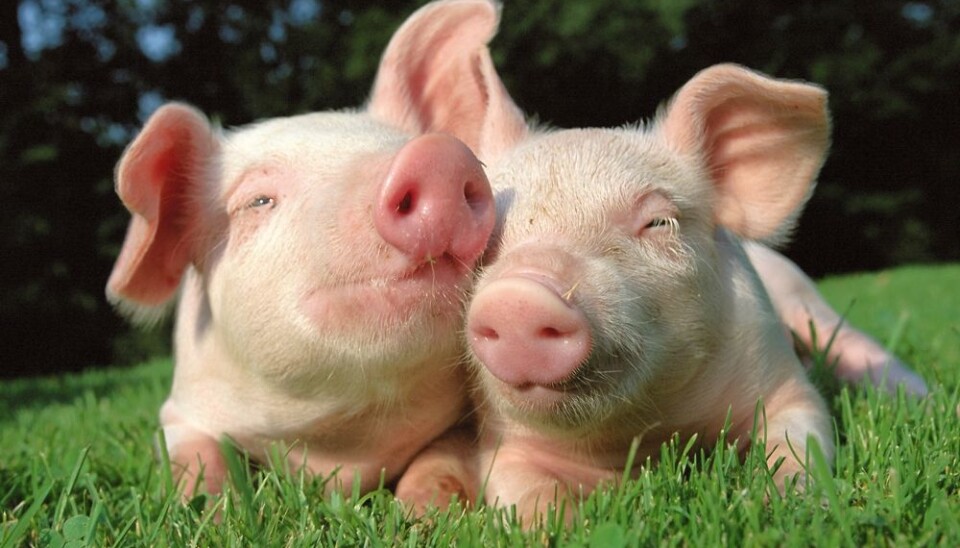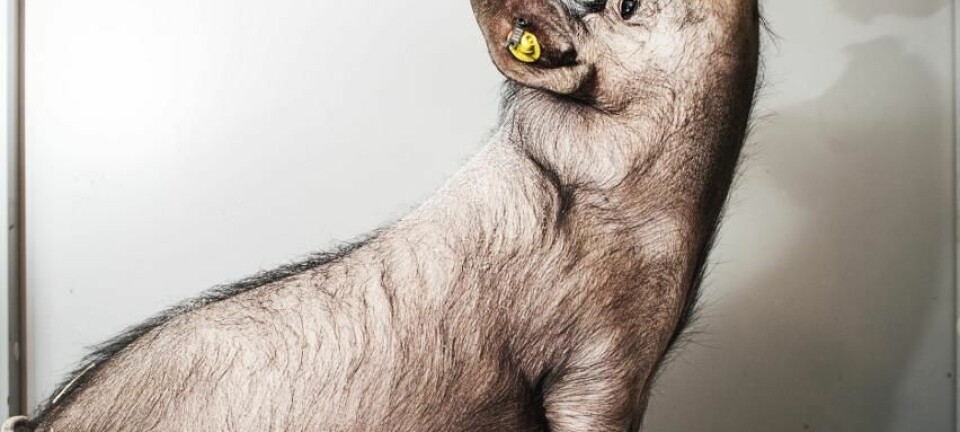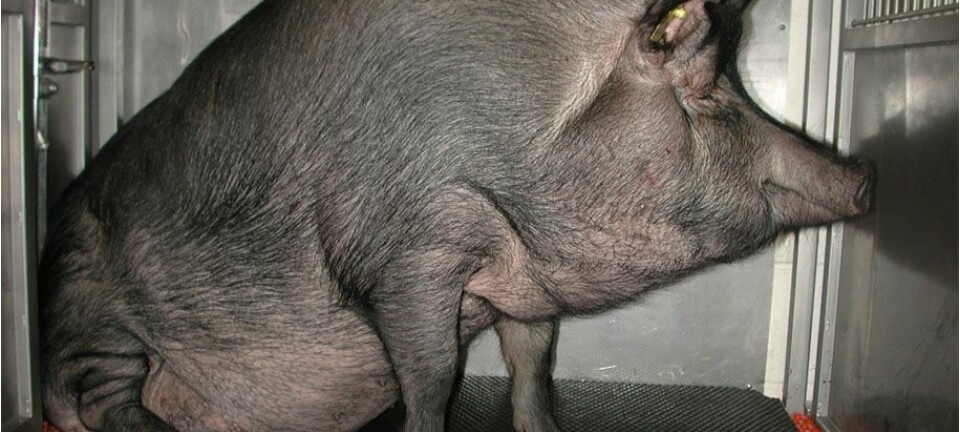
Jolly porkers not a Norwegian priority
Cheap meat means that Norwegians eat more of it, particularly racks of pork spareribs at Christmas. Yet few Norwegian consumers seem to care about the real cost of their pork dinners, especially when it comes to animal welfare.
Denne artikkelen er over ti år gammel og kan inneholde utdatert informasjon.
While most Scandinavians are settling into their post-Christmas routines, Swedish and Norwegian researchers are mulling the true costs of a traditional Scandinavian Christmas feast - and not just for the pocketbook, but for the pigs that supplied the meat.
The experience of eating Christmas pork ribs, called "ribbe", has changed over the decades. Roast pork ribs are no longer the exclusive treat they used to be. A kilo these days costs just €4.62 ($6.35).
Swedish and Norwegian researchers concur – there is something wrong about that price.
“There should be a zero placed to the right of the €4.62 per kilo that ribs often cost,” says Anne-Kristin Løes, a researcher at the Bioforsk Organic’s Research Centre in Tingvoll, in Møre og Romsdal County, Norway.

A lot of work goes into each rack of spareribs before it makes its way into supermarkets. So it seems wrong somehow that Norwegians pay comparatively little for this favorite bony and fat cut of pork at Christmas.
Not sustainable
When pork is as cheap as it is now – and it is even cheaper in Sweden than in Norway – consumers buy more meat than they need.
As a result, leftovers often end up in the rubbish bin without consumers giving it a second thought.
Researchers point out that this is hardly sustainable consumption, not by a longshot.
Getting to live like a pig

While more than half of all Norwegians eat ribbe on Christmas Eve, Swedes lay out their spreads of hot and cold foods, a smorgasbord, which in most homes would be naked without a Christmas ham.
This year many Swedish yuletide feasts included hams from organically raised pigs.
An organic seal, the KRAV stamp, guarantees that the pig was allowed to spend time outdoors in its natural environment. That includes wallowing in mud, which in the mind-set of a pig is like treatment in a five-star health spa.
KRAV pigs also get to forage for their own food outdoors in the summer. The sow is allowed to build its own bed of straw or some similar material to make a cosy spot to give birth to its farrow of piglets.

Simply put, the KRAV pig has been allowed to live like a pig.
New record in Sweden
Swedes have set a new record for the production of organic Christmas pork this year.
A total of 250 tonnes of ham from KRAV-stamped pigs was on sale to consumers. But only six tonnes were sold as KRAV Christmas ham.
The reason is that most of this ham was treated by meatpackers with the additive nitrite, which makes the meat redder and acts as a preservative. This disqualifies it from being marketed with the KRAV seal, but it does get to be sold with the EU’s environmental seal.
Few alternatives in Norway
Norwegian consumers are given fewer opportunities to eat pork from pigs that got to scratch themselves against tree trunks and live happy piggy lives.
The market has only one producer, which sold 6.5 tonnes of ribbe for Christmas.
Customers are eager to get hold of these racks of pork ribs even though they cost about four times as much as ordinary supermarket ribs.
The high cost has at least a little to do with production requirements. For example, these pigs must have at least 200 square metres to waddle around in.
In spite of the price, the producer, Grøstadgris, says demand has been higher than ever this Christmas.
The customers who buy their free range pigs generally come from two age groups, the 35 to 45 year old crowd, and people who are over 60.
Utopian wish for 100 percent organic
Pigs cannot be content unless they can dig into the soil and are members of a drove, says Bioforsk's Løes.
But Løes is a realist. Norway cannot produce all its pork this way.
“This is a demanding way to produce pork. A pig cannot be kept in the same area long before it has to be relocated, as the soil soon soaks up nutrients from the pigs excrement and urine,” says Løes.
If the content of these nutrients exceeds certain limits, the run-off from the area will fuel algae blooms in nearby waterways. Water quality decreases when rivers and lakes accumulate too much of these agricultural nutrients.
To prevent this problem, the pigs have to be moved around a lot, which requires a lot of outdoor space.
“Nevertheless, we should have more producers who supply consumers with this alternative, like they have in Sweden and Denmark,” says Løes.
The way meat is produced is just part of the issue. How much livestock should we be raising? Løes is critical of the way we’ve channelled agricultural production into massive consumption of meat.
Choose your meat carefully
Her concerns are shared by Kristin Palmqvist, professor of ecology and environmental sciences at Umeå University in Sweden.
“For every kilo of meat I eat, five to ten times as much cultivated land is used compared to if I eat a comparable amount of wheat,” Palmqvist says.
“The size of the Earth is finite. We now use 40 percent of the land for food production. Human populations are still expanding and we need increasingly more land to cultivate food,” Palmqvist says.
This makes it harder to find enough space for animal husbandry, whether organic or conventional.
Palmquist’s plea to consumers is unequivocal: “We need to eat less meat. And we have to stop discarding meat.”
Sweden’s National Food Agency has also issued clear recommendations in a recent report.
The agency says that when we eat meat we should chose it with care. We should also buy climate certified or organic products.
A public discourse is underway in Sweden about meat production, animal welfare and related environmental concerns. Swedish television has often broadcast reports from animal rights activists who have documented abominable animal care.
This has motivated many consumers to start thinking more about their meat consumption, according to Palmqvist.
Norwegians swayed by hype
It's harder to find ecological or organic food in Norway compared to its Scandinavian neighbours, Sweden and Denmark.
Researcher Gunnar Vittersø of the National Institute for Consumer Research (SIFO) thinks the reasons for this are complex.
“We are told that as long as we eat Norwegian produce we are safe – Norwegian food is said to be safe and healthy. Producers show us images of contented Norwegian cows in pastures. It’s hard for organic farmers in Norway to outdo this marketing,” he says.
Vittersø says Swedish authorities have placed the issue of meat consumption and production on the agenda, whereas it is pretty much a non-issue in Norway.
Norwegian consumers have almost blind faith in regulators. The food sector is strongly controlled by the authorities. Food and its relationship to the environment have not been of much concern for the authorities or even for Norwegian environmentalists.
“In Norway we also have a public debate running between experts about organic food. This all has a negative impact on consumers' willingness to buy organic alternatives,” says Vittersø.
Ten percent are conscious
Around 10 percent of the consumers in Norway can currently be categorized as “conscious consumers” in the sense that they are concerned about eating high quality food that meets stringent health, environmental and ethical standards.
“Norwegian food chains compete on price rather than quality. This is reflected in the consciousness of the consumers,” Vittersø says.
Translated by: Glenn Ostling


































